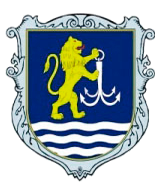MATHEMATICAL MODEL OF TRANSIENT MODES OF ELECTRIC SHIPS’ PROPULSION COMPLEXES WITH THRUSTERS
Abstract
The purpose of the work is to develop a mathematical model and a method for calculating the maneuvering modes of propulsion electrical power plants with thrusters. Methodology. During maneuvering, both the propulsion electric power plant, the thrusters, and the ship’s hull operate in transient modes. The durations of transient processes in them are сommensurate, so the analysis of the behavior of any constituent part of the propulsion complex should be carried out in unity with all other parts. The results. A mathematical model and a method for calculating transient modes of propulsion complexes of electric ships with thrusters have been developed. The operation of thruster propellers is considered taking into account the hydrodynamic processes of their interaction with the ship’s hull, viscous losses and viscous interaction. The criteria of dynamic similarity and the generalized dimensionless parameters of the complex affecting the maneuverability indicators were revealed. The workability of the model and the calculation method is confirmed by the results of numerical simulations, which illustrate the effect of the operation of the thrusters on the electric ships’ maneuverability. Scientific novelty. The model and the calculation method allow calculating the main mode indicators and indicators of the quality of maneuvering of modern electric ships equipped with thrusters. At the same time, control of operating parameters of all components of the propulsion electric power plant is carried out. There is an opportunity to design propulsion plants according to the final result – according to the quality of the vessel’s maneuverability. Practical value. The calculation method will make it possible to conduct a study of the behavior of propulsive complexes during maneuvering, to optimize the control process, and to find ways to increase the electric ships’ maneuverability. Bible. 15, tab. 2, Fig. 7.
Downloads
References
2. Yukun Feng, Zuogang Chen, Yi Dai, Ping Wang. An experimental and numerical investigation on hydrodynamic characteristics of the bow thruster. Ocean Engineering, 2020, vol. 209(8):107348. doi: 10.1016/j.oceaneng.2020.107348.
3. Teresa Abramowicz-Gerigk, Miroslaw K. Gerigk. Experimental study on the selected aspects of bow thruster generated flow field at ship zerospeed conditions. Ocean Engineering, 2020, vol. 209(92):107463. doi: 10.1016/j.oceaneng.2020.107463.
4. Numerical Study of Pressure Fluctuation for Bow Thruster. Journal of Shanghai Jiaotong University , vol. 51(3), pp. 294–299. doi: 10.16183/j.cnki.jsjtu.2017.03.007.
5. Ionut Cristian Scurtu, Valentin Oncica. Combined CFX and Structural Simulation for Bow Thrusters Loading under Operating Conditions. Journal of Physics Conference Series, vol. 1122(1):012024. doi: 10.1088/1742-6596/1122/1/012024.
6. Sardono Sarwito, Semin Semin, Muhammad Badrus Zaman, , Kamarul Hawari Ghazali. Unbalanced Voltages of Bow Thruster Motor Performance in the Ship Using Simulation. International Review of Electrical Engineering (IREE) , vol. 16(5):455. doi: 10.15866/iree.v16i5.18132.
7. Xiao Z., Li H., Fang H., Guan Y., Liu T., Hou L., Guerrero J. M. Operation Control for Improving Energy Efficiency of Shipboard Microgrid Including Bow Thrusters and Hybrid Energy Storages. IEEE Transactions on Transportation Electrification, June 2020, pp. (99):1-1. doi: 10.1109/TTE.2020.2992735.
8. Kupraty O. Mathematical modelling of construction of ship turning trajectory using autonomous bow thruster work and research of bow thruster control specifics. Scientific Journal of Gdynia Maritime University, No. 118, June 2021, pp. 7-23. doi: 10.26408/118.01.
9. Andrzej Kopczyński. Hybrid expert system for computer-aided design of ship thruster subsystems. IEEE Access, Volume 8, 2020. doi: 10.1109/ACCESS.2020.2982264.
10. Ruth, E. Propulsion Control and Thrust Allocation on Marine Vessels. Ph.D. Thesis, NTNU Norwegian University of Science and Technology, Trondheim, Norway, 2008.
11. Jarosław Artyszuk and Paweł Zalewski. Energy Savings by Optimization of Thrusters Allocation during Complex Ship Manoeuvres. Energies 2021, 14(16), 4959; doi:10.3390/en14164959.
12. Яровенко В.А., Черников П.C. Метод расчета переходных режимов гребных электроэнергетических установок электроходов. Електротехніка і електромеханіка, 2017, № 6, С. 32–41. doi: 10.20998/2074-272X.2017.6.05.
13. Яровенко В.А., Черников П.C., Варбанец Р.А., Зарицкая Е.И. Оптимальное управление гребными лектродвигателями электроходов при реверсировании. Електротехніка і електромеханіка, 2018, № 6, С. 38–46. doi: 10.20998/2074-272X.2018.6.05.
14. Гофман А.Д. Движительно-рулевой комплекс и маневрирование судна. Справочник. Л. : Судостроение, 1988. 360 с.
15. Яровенко В.А., Черников П.C., Зарицкая Е.И., Шумило А.Н. Управление гребными электродвигателями электроходов при движении по криволинейной траектории. Електротехніка і Електромеханіка, 2020, № 5, С. 58–65. doi: 10.20998/2074-272X.2020.5.09





